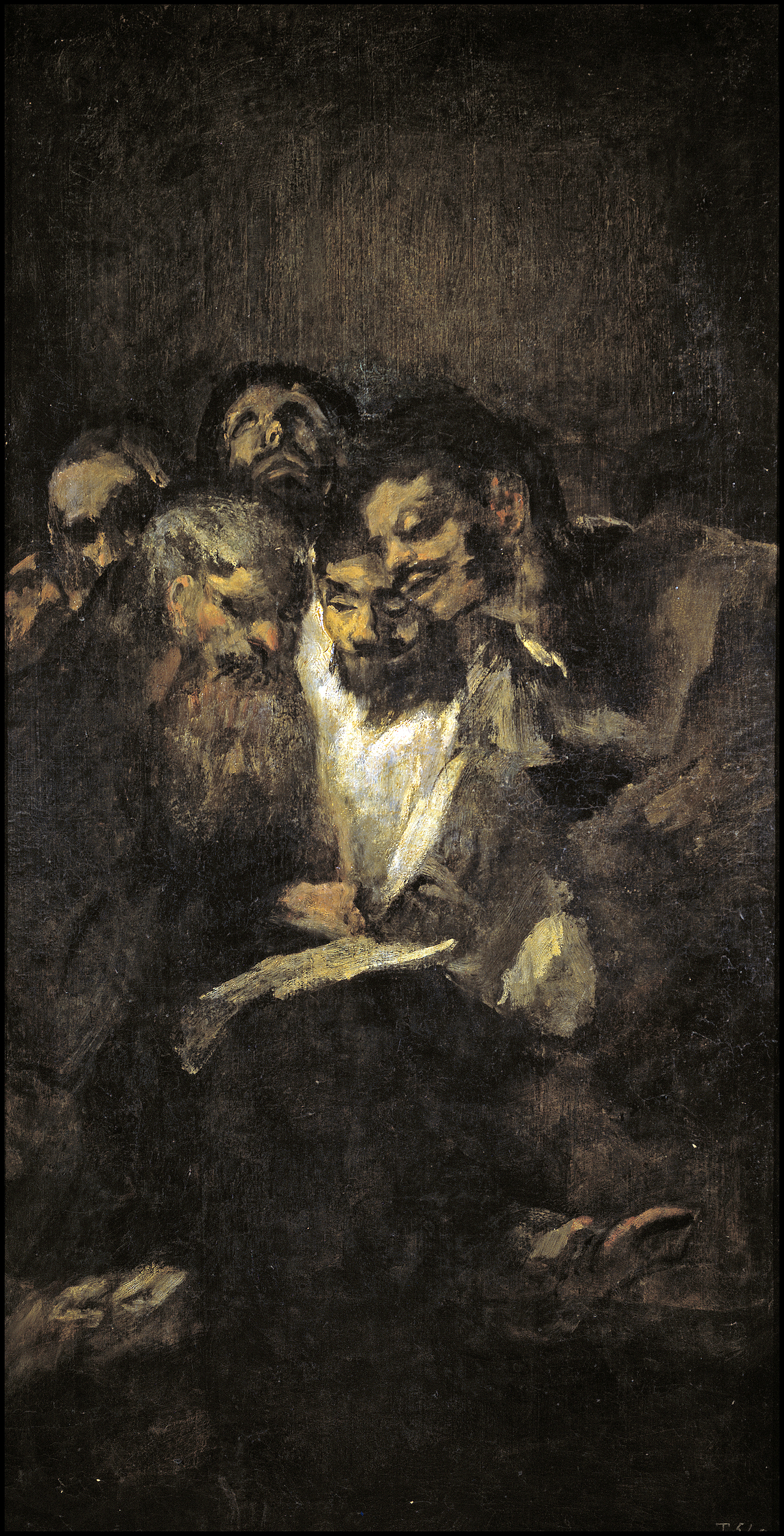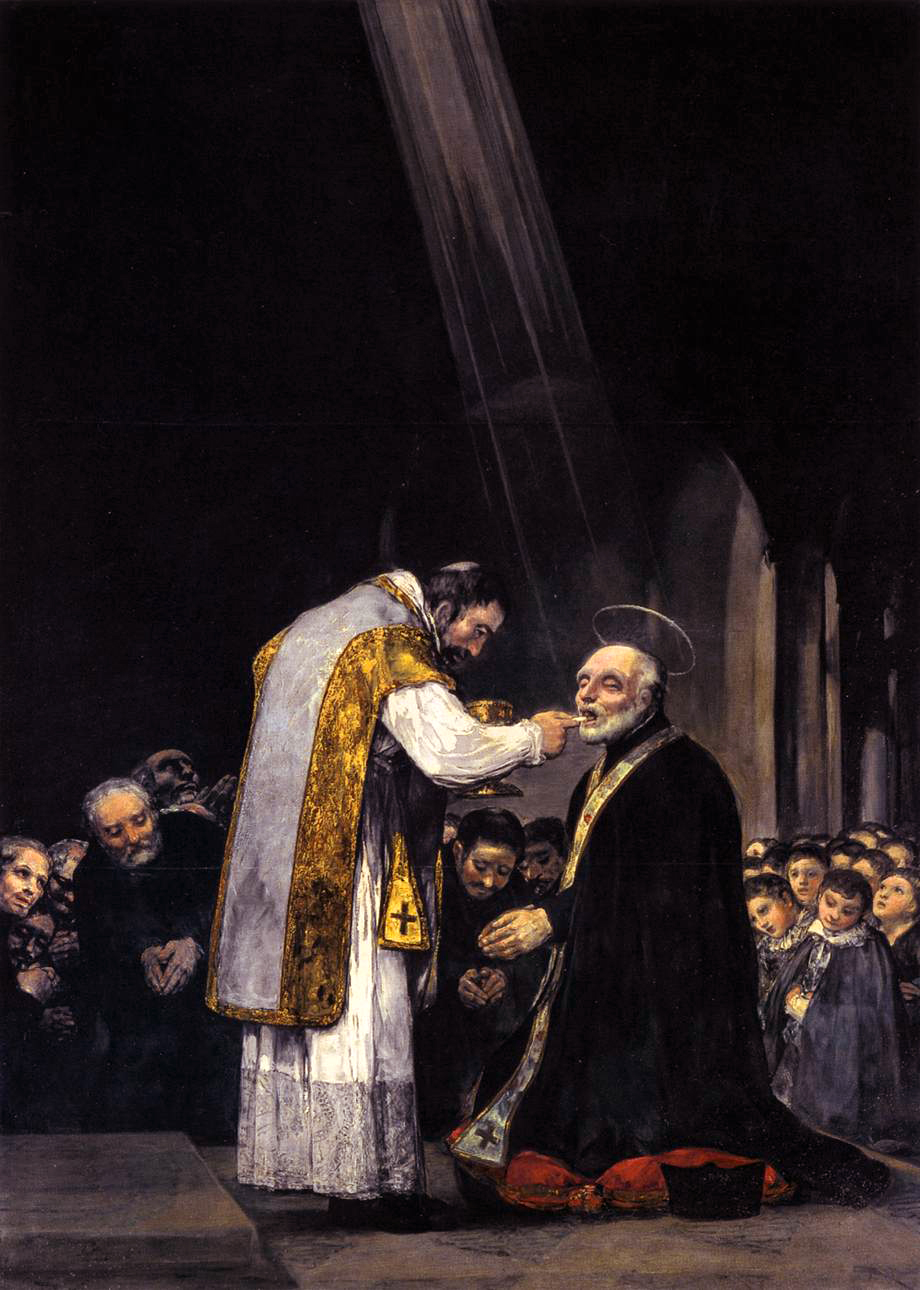|
Black Paintings
The ''Black Paintings'' (Spanish: ''Pinturas negras'') is the name given to a group of 14 paintings by Francisco Goya from the later years of his life, likely between 1819 and 1823. They portray intense, haunting themes, reflective of both his fear of insanity and his bleak outlook on humanity. In 1819, at the age of 72, Goya moved into a two-story house outside Madrid that was called '' Quinta del Sordo'' (''Deaf Man's Villa''). Although the house had been named after the previous owner, who was deaf, Goya too was nearly deaf at the time as a result of an unknown illness he had suffered when he was 46. The paintings originally were painted as murals on the walls of the house, later being "hacked off" the walls and attached to canvas by owner Baron Frédéric Émile d'Erlanger. They are now in the Museo del Prado in Madrid. After the Napoleonic Wars and the internal turmoil of the changing Spanish government, Goya developed an embittered attitude toward mankind. He had an acute ... [...More Info...] [...Related Items...] OR: [Wikipedia] [Google] [Baidu] |
Man Mocked By Two Women
''Man Mocked by Two Women'' or ''Women Laughing'' or (Spanish: ''Dos mujeres y un hombre'' nglish:''Two Women and a Man'' or ''The Ministration'' are names given to a painting likely completed between 1820 and 1823Licht, 159 by the Spanish artist Francisco Goya. It is one of Goya's 14 ''Black Paintings'', a series created near the end of his life on the walls of his home, Quinta del Sordo. He was then living in despair, and the works are oppressively dark in both mood and colour. It shows two women with maniacal smiles seemingly laughing at a simple-minded man who appears to be masturbating at the right hand of the picture. Despite their jeers, the woman to the left may also be masturbating, which—in the absence of any written or oral comment from Goya on any work on the series—art critics and historians believe lends to the image's futile and sterile intent. The ''Black Paintings'' are housed in the Museo del Prado, Madrid. Background At the age of 75, living alone an ... [...More Info...] [...Related Items...] OR: [Wikipedia] [Google] [Baidu] |
Self-portrait With Dr Arrieta
''Self-Portrait with Dr Arrieta'' is the English title given to a painting by Spanish artist Francisco Goya. The work is an oil on canvas, painted in 1820, and is currently held in the Minneapolis Institute of Art, Minnesota. Many scholars have seen religious themes in the work. Other interpretations compare and contrast the painting with Goya's series of Black Paintings, contextualizing the work within his career at large. Background In 1792, Goya developed a sudden, serious illness which included dizziness, weakness, delirium, sickness, abdominal pain, deafness, and partial blindness.Foy J. L. ''The Deafness and Madness of Goya: Conscious and Unconscious Expressive Art''. Vol 3. Basel: Karger, 1971. (Cited in M.P. Park and R.H.R. Park, "The Fine Art of Patient-Doctor Relationships." ''BMJ'' 329 (2004): p. 1,475, and notes 1, 2.)Cawthorne, Terrance. "Goya's Illness." ''Proc Roy Soc Med'' 55 (March 1962): 213–217. By the time he returned to Madrid, in 1793, Goya was completel ... [...More Info...] [...Related Items...] OR: [Wikipedia] [Google] [Baidu] |
Leocadia Zorrilla
Leocadia Zorrilla, married name Leocadia Weiss (9 December 1788, Madrid – 7 August 1856, Madrid), was the old-age companion of Spanish painter Francisco Goya, and mother of the artist Rosario Weiss Zorrilla. Biography Leocadia was orphaned at an early age and her education was provided by her aunt, Juana Galarza. Much of her early life is presumed, rather than known. She apparently met Goya in 1805, at the wedding of his son, Javier, to her cousin, Gumersinda Goicoechea Galarza. In 1807, Leocadia married Isidore Weiss, a Jewish-German jeweler whose family lived in Madrid, and they settled into his parents' home. While living there, she gave birth to two children: Joaquín (1808) and Guillermo (1811). However, in 1811, Weiss had sworn out a legal document accusing her of "illicit conduct", and they separated. Leocadia gave birth to a third child, Rosario, in 1814. Speculation has focused on the possibility of Goya as Rosario's father. This has not been firmly established, bu ... [...More Info...] [...Related Items...] OR: [Wikipedia] [Google] [Baidu] |
Segovia
Segovia ( , , ) is a city in the autonomous community of Castile and León, Spain. It is the capital and most populated municipality of the Province of Segovia. Segovia is in the Inner Plateau (''Meseta central''), near the northern slopes of the Sistema Central range and on a bend of the Eresma river. The city is famous for its historic buildings including three main landmarks: its midtown Roman aqueduct, its cathedral (one of the last ones to be built in Europe following a Gothic style), and the medieval castle, which served as one of the templates for Walt Disney's Cinderella Castle. The city center was declared of World Heritage by UNESCO in 1985. Etymology The name of Segovia is of Celtiberian origin. Although historians have linked its old name to ', the recent discovery of the original Roman city in the nearby village of Saelices discarded this possibility. The name of "Segovia" is mentioned by Livy in the context of the Sertorian War. Under the Romans and Moors, the ... [...More Info...] [...Related Items...] OR: [Wikipedia] [Google] [Baidu] |
River Manzanares
The Manzanares () is a river in the centre of the Iberian Peninsula, which flows from the Sierra de Guadarrama, passes through Madrid, and eventually empties into the Jarama river, which in turn is a right-bank tributary to the Tagus. In its urban section, the Manzanares River was modified to create a section of water several meters deep, in some parts navigable by canoes. This project of channeling and damming has been partially reversed in a re-naturalization project. Course Sources The Manzanares has its sources in the southern slope of the , a branch of the Sierra de Guadarrama (the main eastern section of the Sistema Central), in the municipality of Manzanares el Real, in the Madrid region. It is formally called Manzanares after the confluence of the arroyo de la Condesa and the Arroyo de Valdemartín. The Arroyo de la Condesa is in turn born in the , a traditionally resilient snowdrift, and its watershed comprises the slopes in between La Maliciosa (2,227 m), the Al ... [...More Info...] [...Related Items...] OR: [Wikipedia] [Google] [Baidu] |
Two Old Men Eating Soup
''Two Old Ones Eating Soup'' (Spanish: ''Dos viejos comiendo sopa'') or ''Two Witches'' (Spanish: ''Dos Brujas'')Junquera, 84 is one of the fourteen ''Black Paintings'' created by Francisco Goya between 1819 and 1823. By this time, Goya was in his mid-70s and deeply disillusioned. He painted the works on the interior walls of the house known as the Quinta del Sordo ("House of the Deaf Man"). They were not intended for public display. ''Two Old Men Eating Soup'' likely occupied a position above the main door to the house, between '' La Leocadia'' and '' Two Old Men''. Like the other ''Black Paintings'', it was transferred to canvas in 1874–1878 under the supervision of Salvador Martínez Cubells, a curator at the Museo del Prado, Madrid. The owner, Baron Émile d'Erlanger, donated the canvases to the Spanish state in 1881, and they are now on display at the Prado.Hughes, 16–17 In the image, two elderly figures loom forward from a black background; although they are assum ... [...More Info...] [...Related Items...] OR: [Wikipedia] [Google] [Baidu] |
Asmodea
''Asmodea'' or ''Fantastic Vision'' (Spanish: ''Visión fantástica'') are names given to a fresco painting likely completed between 1820–1823Licht, 159 by the Spanish artist Francisco Goya. It shows two flying figures hovering over a landscape dominated by a large tabled mountain.Junquera, 72 ''Asmodea'' is one of Goya's 14 ''Black Paintings''—his last major series—which, in mental and physical despair, he painted at the end of his life directly onto the walls of his house, the Quinta del Sordo, outside Madrid. No written or oral record survives as to the series' intended meaning, and it is probable that they were never intended to be seen by those outside his then small immediate circle. Goya did not name any of the works in the series; the title of ''Asmodea'' was later given by his friend, the Spanish painter Antonio Brugada. The title is likely a feminine naming of the demon king Asmodeus from the Book of Tobias. Asmodeus also appears in the myth of the Greek Titan Pr ... [...More Info...] [...Related Items...] OR: [Wikipedia] [Google] [Baidu] |
La Leocadia
''La Leocadia'' (Spanish: ''Doña Leocadia'') or ''The Seductress'' (Spanish: ''Una Manola'')Havard (2007), p. 66 are names given to a mural by the Spanish artist Francisco Goya, completed sometime between 1819–1823, as one of his series of 14 ''Black Paintings''. It shows a woman commonly identified as Goya's maid, companion and (most likely) lover, Leocadia Weiss. She is dressed in a dark, almost funeral maja dress, and leans against what is either a mantelpiece or burial mound, as she looks outward at the viewer with a sorrowful expression. ''Leocadia'' is one of the final of the ''Black Paintings'', which he painted in his seventies at a time when he was consumed by political, physical and psychological turmoil, after he fled to the country from his position as court painter in Madrid. According to the c. 1828–1830 inventory of his friend Antonio Brugada, ''Leocadia'' was situated in the ground floor of Quinta del Sordo, Goya's villa which Lawrence Gowing observes was ... [...More Info...] [...Related Items...] OR: [Wikipedia] [Google] [Baidu] |







